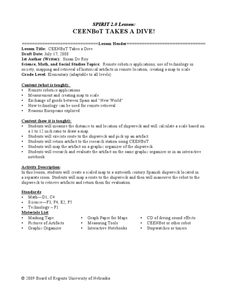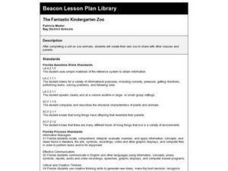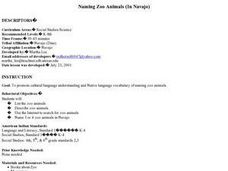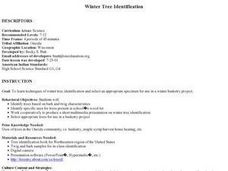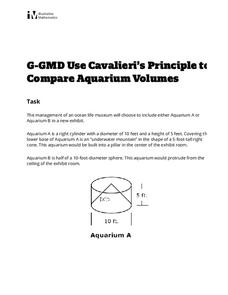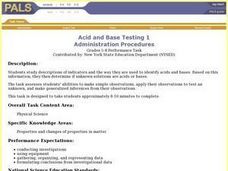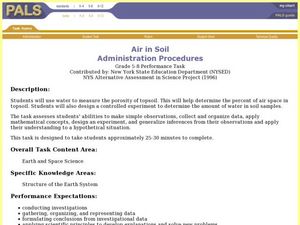Curated OER
CEENBoT Takes a Dive
Students create a map to scale using technology. For this algebra lesson, students navigate through a shipwreck to perform rescues. They use he CEENBoT program to perform the different tasks.
Curated OER
Cell Cycle Duration
Learners examine the cell cycle and how its duration can vary. In this cells lesson students complete a worksheet and answer questions.
Curated OER
Mineral Identification
Eighth graders examine the properties that are used to identify minerals and how they work. In this investigative lesson students use the six properties to identify minerals that they are given.
Curated OER
What is ergonomics and why is it important?
Students come up with ideas to help friendly, superintelligent space aliens adapt to this environment.
Curated OER
Rotation Around the Sun
Third graders participate in a hands-on demonstration of the rotation of the earth around the sun. They identify the equator and the North and South Poles on a Styrofoam ball and then spin the ball on a pencil while they also revolve...
Curated OER
Stormy Weather
Fifth graders demonstrate their knowledge for how animals survive in natural environments when a storm occurs. For this science/writing lesson, 5th graders engage in a listening activity with the teacher. Additionally, students write a...
Curated OER
Observing Osmosis in a Chicken Egg
Tenth graders develop a hypothesis and explain what they observed on an activity. In this investigative lesson students observe osmosis and report their data using a graph.
Curated OER
From Peanuts To Peanut Butter
First graders are introduced to the accomplishments of scientist and inventor George Washington Carver. They get to experience a variety of products created from peanuts and make a collage of the way we use peanuts today.
Curated OER
My Family Tradition
Students examine different family traditions to further explain social patterns. They complete a graphic organizer using educational software.
Curated OER
The Fantastic Kindergarten Zoo
First graders create their own zoo to share with other classes and parents. Groups create displays for the animals. Have each group brainstorm how they create a display for their animal.
Curated OER
Naming Zoo Animals (In Navajo)
Students investigate zoo animals and name various zoo animals in Navajo. They take a field trip to the zoo, take digital pictures of various animals, conduct research, and name each animal in Navajo.
Curated OER
Traditional Soil Remediation in the Garden
Students use testing kits to analyze garden soil. They research the nutritional needs of various crops as well as the nutritional properties of fish. Students participate in fish harvesting for garden fertilizing.
Curated OER
Winter Tree Identification
Students utilize techniques of winter tree identification such as twig and bark characteristics. Students also identify specific uses for trees in school surrounding. They work cooperatively to produce a multimedia presentation on...
Curated OER
SPRING, BABY ANIMALS
Students act out pictures of baby animals from magazines, label each picture correctly, compare and contrast ways of caring for baby animals today with historical ways of caring for baby animals.
Curated OER
Can You Bear It? Pulleys, Gears, Forces, Structures and Mechanisms
Learners review the types of simple machines. As a class, they focus on the positives and negatives of pulleys and gears and identify what pulleys and gears change of an object. They work together to design their own object to support a...
Curated OER
Mythbusters
Eighth graders watch an episode of Mythbusters and answer questions that arise in the video about the scientific process. In this Mythbusters lesson plan, 8th graders complete a scientific investigation based on the video.
Illustrative Mathematics
Use Cavalieri’s Principle to Compare Aquarium Volumes
Learners are designing a stunning new water feature for an aquarium, but they soon discover that more than just a pretty home for their fishy friends is required. From calculating the volume of a composite shape through the abstract...
Teach Engineering
Quantifying Refraction
Class members discover how mathematics can quantify the behavior of light waves with the fourth installment of a seven-part series that teaches future engineers about equations related to refraction, including the equation to calculate...
Curated OER
Acid and Base Testing
Students study descriptions of indicators and the way they are used to identify acids and bases. They use this information to determine if unknown solutions are acids or bases.
Curated OER
Color Dots 3
Students make simple observations, test mixtures, and make generalized inferences from their observations. They observe bleeding of colored inks with water.
Curated OER
Wig-wag Physics
High schoolers make observations on the effects of a small, medium and large weight on the movement of a wig-wag apparatus. They use their observations to develop a generalized inference of the effect weight on movement patterns.
Curated OER
Air in Soil Administration Procedures
Students study soil and its composition. In this soil composition lesson, students study examples of soil during several days of aeration. Students summarize their data, organize it, and must be able to explain their findings.
Curated OER
Mystery Card 2
Young scholars make a circuit on a mystery card. They then use an electrical tester to determine where electricity flows between circles on the card. They will connect wires, bulbs, and a battery to form an electrical tester.
Curated OER
Mystery Card 1
Students test their knowledge of electrical conductors and circuits by constructing an electric tester and using it to determine where electricity flows between circles on a mystery card.


